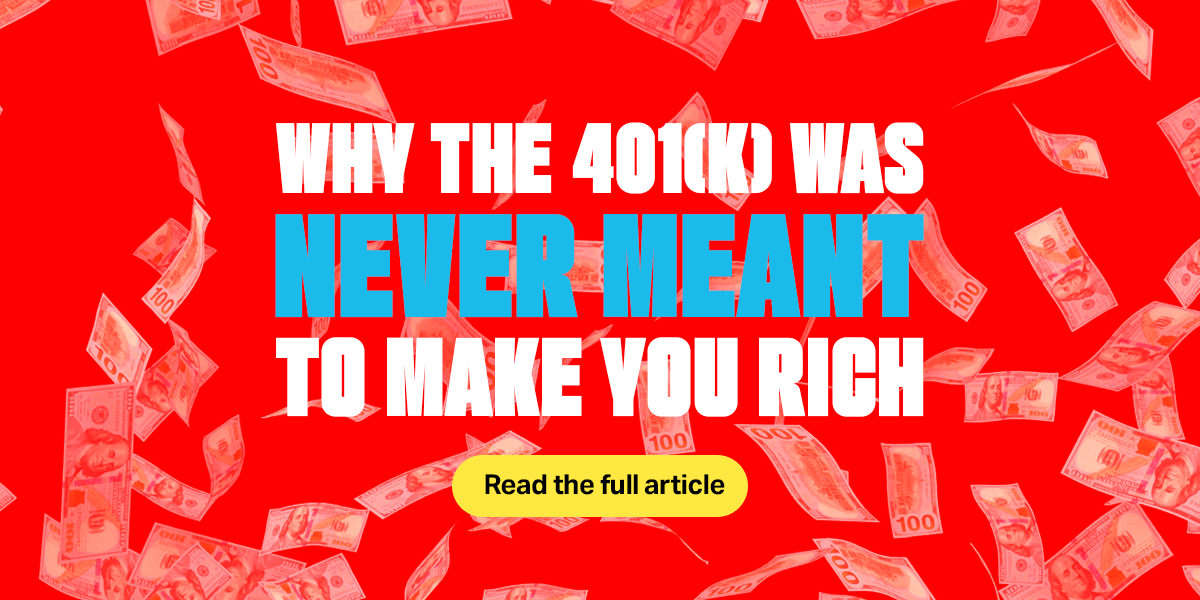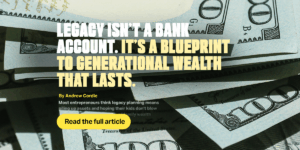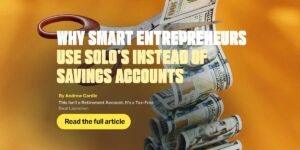The 401(k) wasn’t built for you. It was built to replace pensions—cheaply.
I’ll never forget the conversation I had with my accountant when I first started making real money. She’s sitting across from me with this look like he’s about to save my financial life, and she says, “Andrew, you need to max out your 401(k). It’s the foundation of wealth building.”
I said, “Why?”
“Because that’s what successful people do.”
Even then, something felt off. Here I was, building a business, taking risks, creating value out of thin air and the best advice the financial world had for me was to hand my money over to someone else and hope the stock market didn’t crash when I turned 60.
That didn’t sound like wealth building. That sounded like wealth surrendering.
The Corporate Shell Game
Here’s what they don’t teach you in business school: The 401(k) was never supposed to be your primary retirement plan. It was supposed to be a small supplement to pensions and Social Security.
The whole thing started in 1978 when Congress added Section 401(k) to the tax code. It wasn’t some grand vision for American retirement. It was a tiny provision designed to let executives defer some compensation without paying taxes immediately.
 Then corporate America saw an opportunity. Why pay for expensive pension plans when you could shift the burden to employees? Why guarantee retirement income when you could just provide a tax shelter and call it “empowerment”?
Then corporate America saw an opportunity. Why pay for expensive pension plans when you could shift the burden to employees? Why guarantee retirement income when you could just provide a tax shelter and call it “empowerment”?
By the 1990s, pensions were disappearing faster than money at a casino. Companies realized they could save millions by saying,
“Here’s a 401(k). Good luck figuring out retirement. Not our problem anymore.”
The Contributor’s Trap
The 401(k) system assumes you’re going to be a contributor for your entire working life. Clock in, contribute a percentage, let someone else invest it, and hope it works out in 30 years.
But entrepreneurs aren’t contributors. We’re creators.
We build businesses. We generate cash flow. We buy assets. We create value. Yet the financial system wants us to act like employees—hand over our money, follow their rules, and wait for permission to access our own wealth at 59½.
Think about how insane that is. You can build a million-dollar business by age 35, but the retirement system says you’re too immature to access your own 401(k) money without a penalty.
The Mathematics of Mediocrity
Here’s the dirty secret about 401(k)s: Even if everything goes perfectly, they’re designed to create financial dependence, not financial freedom.
The average 401(k) balance for someone nearing retirement is around $200,000. After 30-40 years of contributions. That’s not wealth—that’s surviving until you die broke.
Meanwhile, the same person could have used that money to buy rental properties, invest in businesses, or build assets that generate cash flow today, not in three decades.
The 401(k) system teaches you to save for retirement. Wealth creators learn to buy assets that pay for life.
Control vs. Hope
The biggest problem with 401(k)s isn’t the fees or the limited investment options, though both are terrible. The biggest problem is that they teach you to give up control.
You can’t control when the market crashes. You can’t control what investments are available. You can’t control when you can access your money without penalties.
You’re betting your financial future on variables completely outside your influence.
Creators don’t hope for wealth. They build systems that create it.
Instead of contributing to a 401(k) and hoping the market cooperates, they buy real estate that generates monthly cash flow. Instead of waiting until 65 to access their money, they structure investments that pay them today. Instead of diversifying across mutual funds they don’t understand, they concentrate on assets they can control.
The Identity Shift
The 401(k) mindset keeps you thinking like an employee, even when you’re a business owner. It’s subtle, but it’s toxic.
Employees save for retirement. Entrepreneurs build wealth engines.
Employees hope their investments grow. Entrepreneurs create cash flow.
Employees wait for permission to access their money. Entrepreneurs structure their wealth to serve them when they need it.
The moment you realize the 401(k) was designed for people who trade time for money—not people who create value from ideas, everything changes.
The Real Game
Wealthy people don’t get rich by maxing out their 401(k)s. They get wealthy by buying assets, building businesses, and creating multiple income streams that work whether they do or not.
They use structures that let them access their money when opportunities arise, not when the government says they’re old enough. They invest in things they understand and can influence, not mutual funds run by people they’ve never met.
The 401(k) was a corporate solution to a corporate problem.
You’re not a corporation. You don’t need their solution. You don’t need to play by their rules.
You just need to know they were never made for you.






